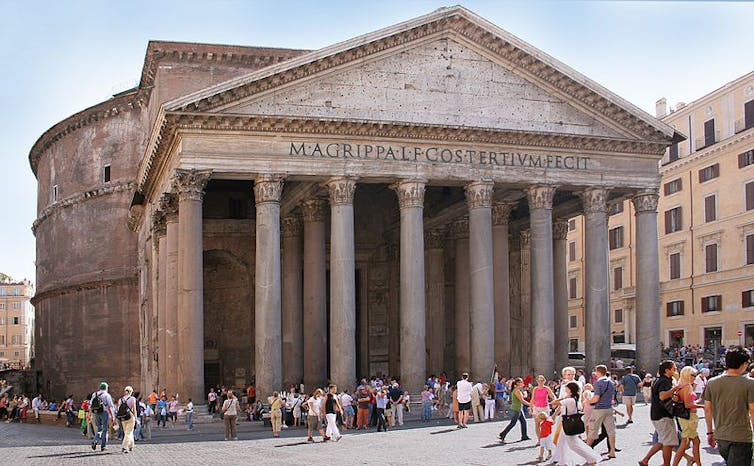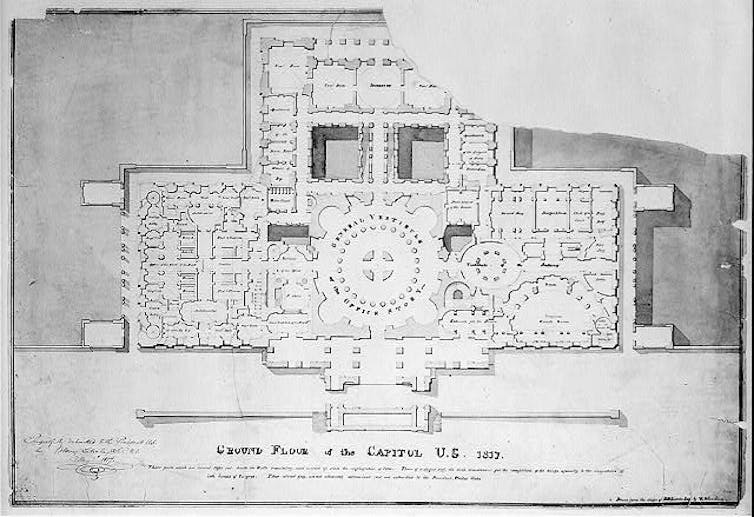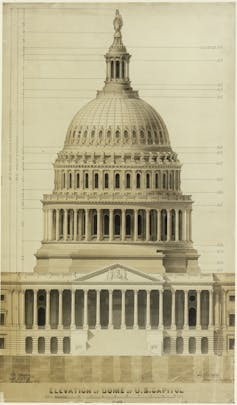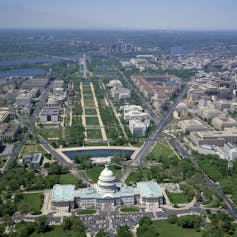Is the US Capitol a 'temple of democracy'? Its authoritarian architecture suggests otherwise
- Written by Megan Goldman-Petri, Part-time Lecturer, New York University
Honoring the Capitol Police officer killed in the Jan. 6 attack on the U.S. Capitol, House Speaker Nancy Pelosi recently invoked the building’s symbolic role in American democracy.
“Each day, when members enter the Capitol, this temple of democracy, we will remember his sacrifice,” she said of the slain officer, Brian Sicknick[1].
Former President Donald Trump was impeached[2] for inciting the mob that attacked the Capitol and is now on trial in the Senate. The insurrection has reaffirmed the building’s almost sacred status.
As the place where American deliberative democracy has been practiced for the past 230 years, the Capitol is in at least one respect a sanctified place. But as a historian of ancient Roman architecture[3] and its legacy[4], I would argue that the architecture of America’s “temple of democracy” is in fact fundamentally anti-democratic.
An American Pantheon
The original design for the Capitol[5], proposed by the amateur architect Dr. William Thornton[6], was based on the ancient Roman Pantheon.
 The Pantheon in Rome.
Roberta Dragan/Wikimedia Commons, CC BY-SA[7][8]
The Pantheon in Rome.
Roberta Dragan/Wikimedia Commons, CC BY-SA[7][8]
President Thomas Jefferson thought[9] the Pantheon was one of the most beautiful buildings ever made: simple, elegant and geometrically perfect – but also an engineering masterpiece, with the largest dome ever built in antiquity[10].
Jefferson believed an American Pantheon would bring beauty to the nation, aiding the moral and civic development of the American people[11]. Since the United States had no domed buildings at that point, its construction would also show the young nation could be the equal of older, grander European nations.
Jefferson, a devoted classicist, knew the Pantheon had been built by emperors[12]. Its original manifestation was devised in the year 25 B.C. by Marcus Agrippa – the right-hand man of Rome’s first emperor, Augustus – as a temple for emperor worship. It was redesigned by Hadrian around A.D. 126 to serve a function that remains enigmatic.
But the stupendous grandeur of its dome and its adornment in marble quarried and shipped from across the Roman empire leads most architectural historians[13] to agree that the Pantheon celebrated Rome’s global dominion.
Indeed, Jefferson very likely chose to model the Capitol after the Pantheon because of, not in spite of, its imperial associations. He envisioned America as an “empire for liberty[14]” – a force bringing civilization westward.
A dome fit for a king
Jefferson’s American Pantheon was never realized.
Subsequent architects substantially altered the design, and what little progress had been made was halted in 1814 when the Capitol was burned[15] by British invaders – joined by some of the very slaves who built it[16] – in the War of 1812.
 A proposed floor plan for the new U.S. Capitol, dated 1817.
Library of Congress[17]
A proposed floor plan for the new U.S. Capitol, dated 1817.
Library of Congress[17]
The new Capitol that emerged from the ashes, completed by Charles Bulfinch in 1826, was already too small for the fast-growing Congress of the fast-growing United States.
 The U.S. Capitol’s dome has outsize proportions.
Office of the Architect of the Capitol[18]
The U.S. Capitol’s dome has outsize proportions.
Office of the Architect of the Capitol[18]
From 1856 to 1866 the architect Thomas U. Walter substantially expanded and reconcieved[19] the building. His vision of the Capitol was inspired by the most celebrated domed buildings of the time: St. Peter’s Basilica in Rome, St. Paul’s Cathedral in London and the Church of Sainte-Geneviève in Paris, among others.
In these baroque cathedrals[20], towering domes signified the ruling power of monarchs and popes. They were meant to awe people with their splendor and magnificence, and in so doing to command subservience.
The U.S. Capitol’s architecture is certainly awe inspiring.
But its design history does not exactly embody the values of a democratic government by and for the people.
Versailles on the Potomac
Today, the Capitol’s authoritarian architecture is enhanced by its imperial setting. The Capitol sits atop a terraced hill overlooking a broad promenade of open lawns, tree-lined boulevards, reflection pools and hundreds of monuments and memorials: the National Mall.
 The National Mall, modeled after the gardens of Versailles.
U.S. Library of Congress[21]
The National Mall, modeled after the gardens of Versailles.
U.S. Library of Congress[21]
This landscape was created as part of a 1901 plan to beautify Washington, D.C., whose monumental core was then filled with slum housing and railyards. A team of leading architects revived Pierre L’Enfant’s original 1791 master plan for the city[22].
[Deep knowledge, daily. Sign up for The Conversation’s newsletter[23].]
In L’Enfant’s original vision of Washington, D.C., the Mall was to be a large formal public garden inspired by the manicured gardens of Versailles[24], a private escape for France’s ruling class. Versailles was designed in the mid-17th century to distance the élites of the royal court from the dreary, dirty city and rough, rude commoners.
Unlike Versailles, the National Mall was intentionally made public. But when people gather there to protest, there’s still a tension between that orderly space and a disruptive but essential democratic activity.
The Capitol, long known as the “people’s house,” has never really embodied democracy in its appearance.
After the insurrection of Jan. 6, the Capitol became a military encampment, and a security fence went up around the building[25]. The sacred symbol of American democracy has become a fortress[26] – the latest addition in a history of anti-democratic design.
References
- ^ she said of the slain officer, Brian Sicknick (www.npr.org)
- ^ Donald Trump was impeached (time.com)
- ^ historian of ancient Roman architecture (www.archeoroma.org)
- ^ its legacy (gallatin.nyu.edu)
- ^ original design for the Capitol (www.govinfo.gov)
- ^ Dr. William Thornton (www.aoc.gov)
- ^ Roberta Dragan/Wikimedia Commons (upload.wikimedia.org)
- ^ CC BY-SA (creativecommons.org)
- ^ Thomas Jefferson thought (www.jstor.org)
- ^ largest dome ever built in antiquity (www.archeoroma.org)
- ^ moral and civic development of the American people (www.routledge.com)
- ^ the Pantheon had been built by emperors (www.jstor.org)
- ^ most architectural historians (yalebooks.yale.edu)
- ^ empire for liberty (press.princeton.edu)
- ^ burned (www.senate.gov)
- ^ some of the very slaves who built it (www.aoc.gov)
- ^ Library of Congress (picryl.com)
- ^ Office of the Architect of the Capitol (commons.wikimedia.org)
- ^ substantially expanded and reconcieved (www.aoc.gov)
- ^ baroque cathedrals (www.scribd.com)
- ^ U.S. Library of Congress (commons.wikimedia.org)
- ^ Pierre L’Enfant’s original 1791 master plan for the city (www.smithsonianmag.com)
- ^ Sign up for The Conversation’s newsletter (theconversation.com)
- ^ manicured gardens of Versailles (www.upenn.edu)
- ^ security fence went up around the building (wgntv.com)
- ^ has become a fortress (www.nytimes.com)
Authors: Megan Goldman-Petri, Part-time Lecturer, New York University

